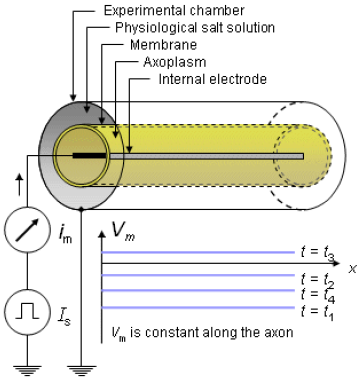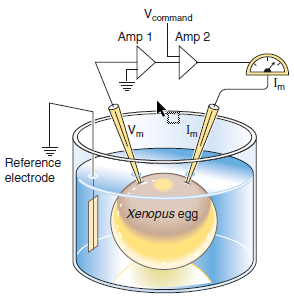Bioelectricity: Electric excitability and action potential
 Space-clamp and voltage-clamp experiments
Space-clamp and voltage-clamp experiments
In a space-clamp experiment you arrange things such that the membrane voltage of a prepared area is the same along the nerve fibre, which means that the voltage does not depend on location, but only on time. To this end, a stimulation electrode is positioned along the longitudinal axis of the nerve fibre, and a round concentric metal cylinder of the same length as the electrode on the outside of the axon. In this case, the voltage can only vary in the radial direction in time, but not along the nerve fibre. In addition, all elements of the membrane react synchronously to changes in experimental conditions. The figure below shows a space-clamp experiment schematically.

In a voltage-clamp experiment, the potential difference across the membrane is held from the outside at a desired constant value by the injection of current into the cell. What happens in such an experiment is the following feedback loop:
- measure the membrane voltage;
- If the membrane voltage deviates from the desired voltage, inject current;
- measure the needed current: this has the same value but opposite direction of the current flowing through ion channels of the membrane.
In the figure below, the voltage-clamp technique is schematically illustrated.
 In a voltage-clamp experiment we measure at the same time the membrane voltage and current through the ion channels. Hodgkin and Huxley were able to manipulate of experimental conditions such that only one of the ion channel types were open, i.e. conductive. This allowed them to experimentally establish per ion channel type the conductivity during stepwise changes in membrane voltage. For each ion channel type, they constructed a mathematical model that describes the data well. In the following sections we look at their results.
In a voltage-clamp experiment we measure at the same time the membrane voltage and current through the ion channels. Hodgkin and Huxley were able to manipulate of experimental conditions such that only one of the ion channel types were open, i.e. conductive. This allowed them to experimentally establish per ion channel type the conductivity during stepwise changes in membrane voltage. For each ion channel type, they constructed a mathematical model that describes the data well. In the following sections we look at their results.
Remember that at the time of the investigation of Hodgkin and Huxley not much was known about the existence and functioning of ion channels; their work was full of assumptions that could only be verified later and experimentally underpinned. The patch-clamp technique developed in the seventies and eighties of the last century, through which the existence of ion channels in the cell membrane could be detected and properties of individual channels could be explored experimentally, played a crucial role in further understanding of ion channels. That is why the inventors of this technique, Neher and Sakmann, received the Nobel prize for their work in 1991.


